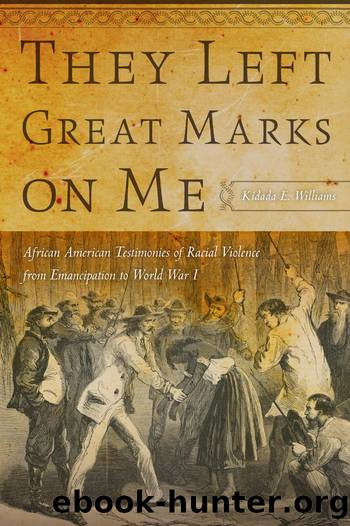They Left Great Marks on Me by Kidada E. Williams

Author:Kidada E. Williams [Williams, Kidada E.]
Language: eng
Format: epub
Tags: History, United States, 20th Century, Social Science, Ethnic Studies, American, African American & Black Studies, Discrimination
ISBN: 9780814795361
Google: 9HnI422eq24C
Publisher: NYU Press
Published: 2012-03-12T22:17:24+00:00
Conclusion
The race conflagrations during and following the First World War were signs of the enduring significance of the vernacular history of racial violence and African Americansâ increasing political mobilization. Public figures publicized racial violence. They advised blacks to defend themselves and counseled white citizens and federal officials to play a role in ending violence. Though public figuresâ entreaties to white people may have fallen on deaf ears, their directives to black people did not.
The intensity of black peopleâs responses to racial violence in 1919 stunned Americans who had previously dismissed and ignored black public figuresâ efforts to publicize victimsâ and witnessesâ testimonies of violence and to educate Americans on the impact of violence on black people and its potential implications for the nation. These riots exposed Americansâ anxieties about race, sex, labor, and politics, anxieties that the conditions of the war had exacerbated. Ordinary racial violence, legal disfranchisement, and segregation had not been enough to quell black peopleâs defiance of white supremacy, so whites resorted to greater attempts to demonstrate their racial superiority in response to black peopleâs insistence on protecting their civil and political rights. Black public figures contextualized the riots in terms of African Americansâ suffering from the hydra of white supremacy. For black peopleâs long-term pain and for their wartime patriotism, black public figures reported that black people expected an end to the violence and to white peopleâs efforts to resubjugate them. When black women and men returned violence with violence, some public figures celebrated it. These people expressed the cumulative weight of racial violence, the limits of African Americansâ endurance of it, and the federal governmentâs apathy toward their plight. Black public figures even started to enjoy more support from such white progressives as James E. Gregg, who was principal of the Hampton Institute and penned an essay describing the âalarming, ominousâ riots and offering suggestions to âprevent such horrors from ever happening again.â Gregg argued, âThese race riots of 1919 ought to be the last that disgrace the United States; and it is the duty of us all to see that this ideal is made fact.â Gregg attributed the riots to a history of neglected opportunities to cultivate mutual respect and understanding between blacks and whites. Gregg argued that black and white rioters should be brought to justice.80
Black peopleâs actions during the riots brought public figuresâ predictions about the consequences of the hydra of white supremacy to fruition. African Americansâ resistance during the riots sent ripples throughout a shocked nation as white citizens and local, state, and federal officials pondered the possibility of a black rebellion. Black peopleâs willingness to defend themselves precipitated white-supremacist retribution that was more violent and government action that was intended to suppress âNegro radicalism.â What the nation learned from the public figures during the Great War was that when blacks returned fighting, they would do so with every weapon in their arsenal, including self-defense. As black peopleâs defensive stance during the riots showed, public figures were not the only blacks who resisted racial violence.
Download
This site does not store any files on its server. We only index and link to content provided by other sites. Please contact the content providers to delete copyright contents if any and email us, we'll remove relevant links or contents immediately.
| General | Discrimination & Racism |
Nudge - Improving Decisions about Health, Wealth, and Happiness by Thaler Sunstein(7662)
The Fire Next Time by James Baldwin(5390)
iGen by Jean M. Twenge(5387)
Adulting by Kelly Williams Brown(4536)
The Sports Rules Book by Human Kinetics(4348)
The Hacking of the American Mind by Robert H. Lustig(4342)
The Ethical Slut by Janet W. Hardy(4220)
Captivate by Vanessa Van Edwards(3818)
Mummy Knew by Lisa James(3662)
In a Sunburned Country by Bill Bryson(3509)
The Worm at the Core by Sheldon Solomon(3457)
Ants Among Elephants by Sujatha Gidla(3442)
The 48 laws of power by Robert Greene & Joost Elffers(3152)
Suicide: A Study in Sociology by Emile Durkheim(2990)
The Slow Fix: Solve Problems, Work Smarter, and Live Better In a World Addicted to Speed by Carl Honore(2979)
The Tipping Point by Malcolm Gladwell(2874)
Humans of New York by Brandon Stanton(2849)
Handbook of Forensic Sociology and Psychology by Stephen J. Morewitz & Mark L. Goldstein(2679)
The Happy Hooker by Xaviera Hollander(2673)
